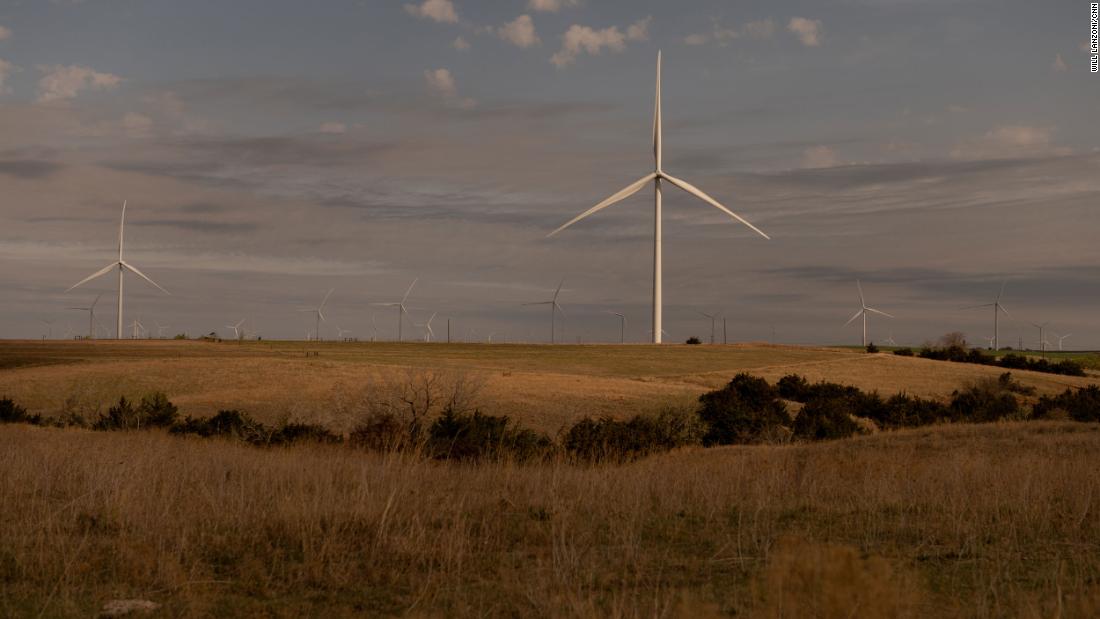
From oil and gas booms and busts to heavy rains followed by drought, Oklahoma is no stranger to extremes. One constant is the wind, which is so bracingly strong that what locals call a breeze will send hats flying and whip open car doors suddenly.
“We’ve always had the wind in Oklahoma,” said Melva Dickey, a 91-year-old landowner and retired farmer.
Dickey leases her land to Ohio-based utility American Electric Power. With four turbines on her property, she — along with more than 300 other landowners — are harnessing the state’s most plentiful natural resource.
Far from the coasts, wind energy is thriving here in America’s heartland, on the vast plains of Oklahoma, Texas and Nebraska. Long an area devoted to oil and gas, Western Oklahoma is now home to one of the largest wind farms in the world.
But Weatherford Mayor Mike Brown told CNN that for the landowners in Western Oklahoma, the sound of a huge metal blade cutting through the atmosphere is “the sound of money.” For people who have long lived with wind whipping across their flat land, using it to make electricity is common sense.
“People look at it like, ‘Okay, I don’t see the negative of it,'” Brown said. “The landowners are benefiting; we’ve benefitted from the workers. It’s ‘how does it affect us?’ Some things we can’t control, this is something we can.”
The farmers who lease their land for wind energy hope it brings new financial stability to the area. Those who spoke with CNN said AEP will deliver 6-month payments to landowners based on how much electricity their turbines generate, as well as a base payment. Even people leasing land without a turbine on it will get a yearly check.
“As long as they’re spinning, they’re making us money,” said Scott Hampton, who farms a small herd of cattle and works at the local school. “In my view, it’s not a fight; it’s what can we do that’s good for the environment.”
A red-state boom
Wind energy is on the brink of a massive expansion in the next few years, data from the US Energy Information Administration shows. Of the wind projects becoming operational this year, Traverse is by far the biggest.
Texas, in addition to being an oil and gas giant, is also a wind behemoth. In 2020, Texas generated more electricity from wind than Iowa, Kansas, and Oklahoma — the next three highest states — combined, according to the EIA. Still, because Texas is massive and both generates and uses the most total electricity out of any state in the nation, wind only accounted for 20% of its generated electricity.
Non-hydropower renewables generated nearly 94 billion kilowatt-hours on that grid in 2021 and are poised to grow to nearly 115 billion kilowatt-hours by 2023, according to the EIA. In comparison, non-hydro renewables generated just 7 billion kilowatt-hours for New York’s grid in 2021.
There are a few reasons wind is thriving in the middle of the country, said Ben King, a senior analyst at the nonpartisan think tank Rhodium Group. It’s an ideal location for consistent wind, it’s easier to build big projects in states that have streamlined their permitting process, and there are more utilities serving the area looking to invest in renewables.
“It has made it easier for wind developers to come in and put wind farms there,” King said.
“All those investments are more risky than a renewables investment,” AEP CEO Nick Akins told CNN. “We’re moving towards a clean energy economy; nothing’s going to stop that.”
A 300-foot office
On a blustery April morning, Traverse plant manager Lance Hull pointed to the end of a turbine blade that was bending slightly with the wind. That slight flex is how Hull knows the wind is blowing at optimal speed to generate electricity.
“We want as much wind to hit that blade and push it as we can actually catch,” Hull told CNN.
The machines do a lot of the work themselves. Standing under a turbine, you can sometimes hear the motor that pivots the blades so they face whatever way the wind is blowing. The turbines themselves can also adjust to spin slower or faster than the wind — trying to maintain the most favorable speed to generate electricity.
“The machine actually takes into account the fact that we can’t control the power that pushes the machine because it is wind,” Hull said. “You can’t control the wind.”
Even though Hull’s title is “plant manager,” there is no plant at Traverse in the sense of a traditional coal- or gas-run power plant. Instead, Hull and his crew of about 50 workers spend their days driving, doing spot checks and maintenance on their turbines — which usually means climbing up the turbines themselves.
“Your office is at 300 feet,” said Blake Panek, a senior wind technician at AEP who works on Hull’s crew.
Climbing and being comfortable with heights is an essential part of being a wind technician. Decked out in a safety harness and attached to a pulley system, Panek charged up a ladder in the inside of the wind towers — scaling the first section in a matter of seconds.
Hull has been with AEP for years, but recently made the switch from a natural gas power plant to the wind farm. And in terms of the number of employees, he doesn’t see a big difference. He estimated his old gas plant had about 30-40 people employed, whereas his wind crew makes up about 50.
“There are a lot of jobs with the wind farm that you don’t have at the typical power plant,” Hull said. “Industries change, things change, but there’s a lot of automation in the gas plants as well. It’s automatic control, people monitoring operations. It’s very similar.”
‘Magnificent structures’
The smallest wind turbines in Weatherford are the ones adorning Mayor Mike Brown’s business card holder on his desk.
Turbines are something of a mascot for Weatherford, a small city that’s home to about 12,000 people but is an economic hub in the area. There’s a massive turbine blade outside city hall on which a local artist painted a colorful mural.
Brown initially had another idea for it: Covering the blade in sandpaper and hoisting it upright on historic Route 66 — “the world’s largest nail file.”
“I got shot down so quickly,” Brown laughed. “I really thought I’d come up with something.”
To hear Brown tell it, the wind boom took off after oil and gas started to decline in the area.
“Really, when the oil fields kind of slowed down, the wind energy picked up,” Brown said. “It really was at a good time for us as far as not seeing a big drop-off.”
Brown’s point speaks to something a lot of people in Western Oklahoma understand. Having lived through multiple boom-and-bust cycles for oil and gas, they’re keenly aware that fossil fuel is a finite resource. And though oil and natural gas are clearly still a big employer in the area, land owners and local officials see wind energy and jobs as complementing fossil fuels, not taking away from them.
“We have a tradition in Oklahoma of being energy producers,” said Rep. Frank Lucas, who has long represented Western Oklahoma in Congress. “We’ve always been oil and gas. It’s only inevitable that as the other forms of energy have been developed, we would be a part of that.”
Lucas, the ranking member on the House Committee on Science, Space, and Technology, says he believes electricity will eventually be carbon-free — and that wind can be a big part of that. Biden has vowed to get the nation’s electricity to be zero-emissions by 2035; whether or not that goal can be met will ultimately depend on many more projects like Traverse coming online.
“In the modern era, we are producers of a lot of wind power, but we can produce more,” Lucas said of his district. “The kind of power we’re talking about is a transition power. We’ll get to an emissions-free primary power source.”
Of course, not everyone is happy with the windmills. On quiet days, the whooshing sound is more noticeable and the spinning blades can cast a flicker of sunlight on bright days. At night, the red lights on the windmills all blink at the same time to ward off airplanes.
“It’s visual pollution,” landowner Melva Dickey admitted, but she still thinks the turbines are “magnificent structures.”
“They’re pretty,” she said. “When the clouds are deep blue and the sun is shining on those turbines, it’s gorgeous.”
Thinking about the future
Cathy Baker has been thinking a lot lately about the older and younger generations of her family of farmers.
Cathy’s parents started farming in the area in 1947, a year before she was born. Her husband Terry has been working on the family farm since 1964. Farmers’ relationship with the land is tied deeply to family in Western Oklahoma, where land is typically passed down from generation to generation.
The Bakers leased their land to AEP, and now have one wind turbine on Cathy’s great-grandfather’s land, one on her grandfather’s land, and another one on her parents’ land.
“Past generations mean a lot to me. I wonder how they’d feel about it,” Cathy Baker said. “I hope they’d like it. They all went with the flow. It’s just progress, it’s the way it is.”
Parts of the Oklahoma panhandle have now gone 236 days without a quarter of an inch of rain in a single day; essentially, no substantial rain since last year, said Oklahoma’s state climatologist Gary McManus.
“Right now, the farmers are praying” for rain, said farmer Scott Hampton. If they don’t get rain in the next few weeks, this year’s wheat crops could fail.
The Bakers suffered losses in their cattle herd during the severe freeze in February 2021, and there’s always the threat of wildfires that get fed by the blustery winds. The Bakers see their wind turbines as another form of insurance.
“It’s kind of like if y’all are going to get a bonus on your paycheck,” Terry said. “Money talks. We need what we can get.”
The local schools are poised for a windfall, too. Energy projects in Oklahoma help the tax base to pay for public schools. The local school district could be looking at replacing about $150,000 in state aid with several millions of dollars in tax revenue from the Traverse wind project, superintendent of Thomas-Fay-Custer unified school district superintendent Rob Friesen told CNN.
“Seeing those things up and turning, it gives us a little bit of hope for what the future might look like, because it will be a game changer for our budget, beyond belief,” said Friesen. “It will allow us to take care of our kids.”
The Bakers are particularly eager to take advantage of this new wind boom; they explored oil and gas leasing on their property years ago, but the wells the company drilled both turned up dry.
“We didn’t get a thing from it but the damage from the site,” Terry recalled.
In contrast, Cathy believes the income generated from leasing their land for turbines will be more “stable,” and add to the value of their property for their children and grandchildren.
“It’s a constant here in Oklahoma; we wouldn’t know what to do if it wasn’t windy,” she says with a laugh. “Who knows what the future holds, but I can see this going on for quite some time — the wind will be harnessed.”
And just as Baker wonders what her ancestors would think about having three massive wind turbines turning high above their cattle fields, she hopes it will benefit the future generations to come.
“I often wonder what my grandchildren are going to see,” she said. “We don’t always think we’re going to like change. But usually when it happens, it’s just fine.”

